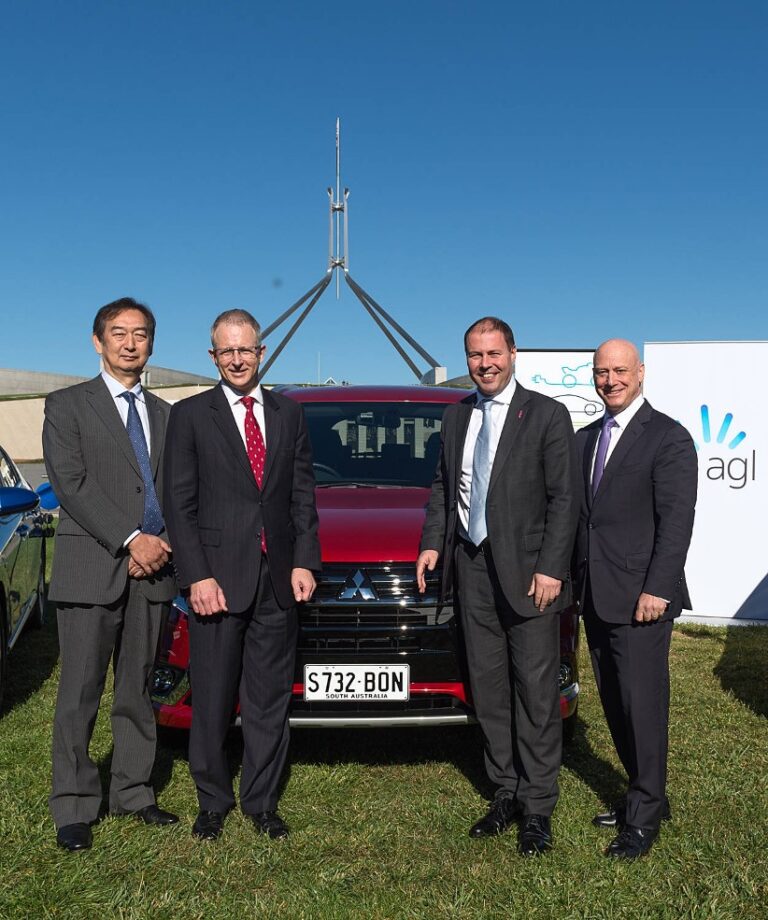AGL Energy has made the largest order to-date of the new Mitsubishi Outlander PHEV plug-in hybrid SUVs with an additional 32 new vehicles added to its national fleet, to take its total Outlander PHEV fleet to 36 vehicles.
AGL Energy is one of Australia’s leading integrated energy companies and the largest ASX listed owner, operator and developer of renewable energy generation in the country.
The purchase of Outlander PHEV allows AGL to utilise the benefits of world’s first hybrid electric SUV and its electric vehicle efficiency without the range anxiety of a pure electric vehicle.
Mitsubishi Motors Australia CEO, Mutsuhiro Oshikiri, attended the launch of the Electric Vehicle Council in Canberra today where AGL Energy confirmed its order of the Outlander PHEVs.
“AGL Energy’s purchase of the new Outlander PHEV further showcases the ongoing commitment AGL has made to reduce its impact on the environment,” Mr Oshikiri said.
“The Outlander PHEVs are a versatile choice as they offer all of the benefits of an electric vehicle, including the quiet and effortless operation without any of the compromises that a pure electric vehicle can put on a driver.”
AGL Managing Director and CEO Andy Vesey said AGL will commit to purchase 36 Mitsubishi Outlander Plug-In Electric Vehicles (PHEVs) to help meet our goal of 10 percent of our business car fleet being electric by mid-2018.
“We are committed to leading the development of distributed energy technologies and are on our way to operating the largest fleet of plug-in vehicles of any Australian business.
“We encourage Australian governments and companies to meet or better our EV uptake commitment. If other Australian fleet operators, including government, adopted a 10 percent target it would result in more than 43,000 EV sales per year and reduce up to 85,000 tonnes of greenhouse gas emissions annually.
“We also advocate for market and policy reform to help overcome key barriers to encourage people to buy EVs in Australia and enhance their ownership experience. And we recognise the commitment and coordination required across Australia’s emerging EV market to ensure this is achieved.
“We look forward to working with the EV Council, the Federal government and industry partners including Mitsubishi Australia to enhance that end goal,” said Mr Vesey.
AGL also announced a new program for AGL employees which offers a tailored novated leasing bundle including the Mitsubishi Outlander PHEV, AGL Electric Car Plan and home charging solution.
“By partnering with car manufacturers we can harness insights and offer practical solutions to consumers through new products and services they value,” added Mr Vesey.
Last year, AGL introduced the Electric Car Plan which includes $1 a day unlimited home charging of electric vehicles to AGL customers, providing them certainty on the low costs of EV operation. The plan also provides zero emissions through carbon offsets from AGL’s Future Forests program.
The new Outlander PHEV boasts combined fuel efficiency of just 1.7-litres per 100 kilometres* – the lowest official ADR fuel consumption figure of any SUV sold in Australia.
The Outlander PHEV has all of the user-friendly attributes of a regular SUV, with its generous five-seat interior and cargo area, 1,500kg braked towing capacity and capable four-wheel drive ability.
The development of plug-in hybrid vehicle technology is a key focus for Mitsubishi Motors and will play an important role in its future models.
About Mitsubishi Outlander PHEV
The Outlander PHEV is the world’s first plug-in hybrid 4×4 SUV and the first of a new generation of Mitsubishi products to feature its advanced Plug-in Hybrid Electric Vehicle propulsion system.
This ground-breaking technology gives the Outlander PHEV an official fuel consumption of 1.7 litres/100km* and 54 kilometre** electric range. With its spacious five seat interior, medium-sized SUV practicality, four-wheel drive capability and starting price of just $50,490 recommended retail, the Mitsubishi Outlander PHEV heralds a new era of affordable, user-friendly electric cars.
* Based on the official ADR 81/02 combined fuel consumption test cycle
** Based on official ADR 81/02 testing






